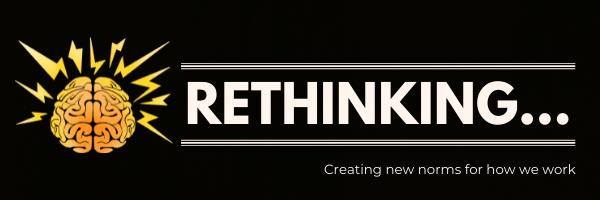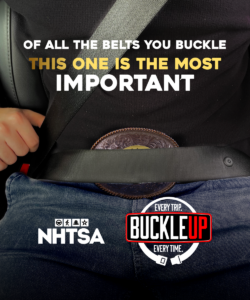
Rethinking…timelines
Rethinking…creating new norms for how we work.
The “Rethinking…” series will explore some of the standard or traditional ways we do our work and why it’s worth rethinking these norms. They are intended to provide healthy food for thought and inspiration for making small steps towards change in how we work.
If you missed the first posts in the series, then catch up here: Rethinking…Sacrifice || Rethinking…Job Requirements || Rethinking…Our Starting Point

Let’s talk about seat belts for a minute
Wearing a seat belt can reduce your risk of having a fatal injury from a car crash by 45%. In essence, it can help save your life.
If for any reason you forget to put on your seatbelt, then your car will remind you with a never-ending series of beeps until you buckle up.
And if you choose to defy the beeps and the safety factor, then you still risk getting pulled over and fined for breaking a law.
To me, this seems like an obvious behavior to adopt.
It’s easy to do, and doing so can save my life, prevent me from hearing annoying car beeps, and avoid breaking the law.
These benefits of doing the behavior are probably why 90% of Americans wear their seatbelts on a regular basis. Yay!
And yet…we continue to receive behavior change messages reminding us that “seat belts save lives” and we should “click it or ticket”.
If 90% of American drivers are already doing the desired behavior, then why does this campaign effort continue?
Well…
» Not everyone wears their seat belt correctly or on every trip they take.
» Passengers in the back seat don’t wear seat belts 90% of the time.
» Every year, there is a new generation of drivers joining us on the road. (And they are joining during a particularly rebellious time in their lives.)
This highlights that even when our behavior change efforts achieve a 90% adoption rate – which most of us would be THRILLED to achieve in our projects – we can’t consider it “done” and stop our efforts.
» Because even if people are doing the behavior, they may not be doing it as effectively as they could be.
» Because even if people are doing the behavior consistently, we may need them to begin adopting a new, related behavior (like wearing seat belts when they are back seat passengers).
» And because every year there is a new generation of our audience that we need to engage.
Which means…
We’re never done changing behaviors.
This is why we should be…
Rethinking our timelines
How long does it take to achieve behavior change?
This is a question that frequently comes up when I share the Diffusion of Innovation theory, and there’s no easy answer.
The rate of adoption will differ for each project depending on the size of the audience, the type of action or behavior being pursued, how ready and willing the audience is to make a change, and whether enabling conditions are in place.
Yet I worry that underneath this question about how long change takes is a hidden question that we may not want to ask out loud. Maybe it’s something like:
» When will we be done with this project, so we can move on to others?
» When can we declare success?
» We only have funding for two years. Can we achieve behavior change in that amount of time?
As the seat belt example shows us, we should plan to be in it for the long haul.
Shifting behaviors and societal norms takes time.
YES, we can do more to see greater momentum and faster results that propel our efforts beyond the early adopters into the early majority audience segment. That’s where behavioral insights and communication strategies come into play.
But that still doesn’t mean behavior change won’t take time, or that we should plan to stop having a presence with our behavior change messaging even once we’ve achieved 90% adoption.
Rethinking…funding.
Rethinking our timelines and planning for the long haul means we also need to rethink our funding mechanisms.
Across the world, there are examples of behavior change campaigns ending because funding ended.
The contract comes to a close, phase two funding doesn’t come through, and other funding sources aren’t secured. So, the project ends.
This reality of funding timelines being short and without guaranteed extensions is often what’s behind the question of “how long will it take?” It stems from the urgent desire to show quick results to secure the next tranche of funds to keep the project going as long as possible.
I understand how planning for the long haul with behavior change feels impossible when we can’t guarantee how much funding we’ll have for FY2023, let alone fifty years later (FY2073).
But this wouldn’t be the rethinking series if we didn’t spend time thinking about how we can create new norms for how we work!
So let’s consider some options.
Making the project a core pillar of the organization.
This won’t always solve the issue, but it helps if the behavior change effort represents part of the organization’s core mission. This can build in some level of sustained effort since it remains consistent year over year, to which both restricted and unrestricted funding can be allocated.
This is easier done for smaller organizations with more narrowly defined scopes as the projects and the organization tend to be tightly linked.
For organizations with many threads of activity, this can be a helpful prompt to consider if resources are spread too widely and thinly across projects and if doubling down on a few core goals would help sustain efforts.
Partnering with others who can be there for the long haul.
It’s possible that being in it for the long haul is simply not feasible for the project, or is antithetical to the mission of the organization. In these cases (and frankly, in all cases), it’s beneficial to partner with an entity that plans to stick around and can take over ownership of the effort.
We typically work with a local government or community-based NGO for this step, yet I also encourage us to consider the role corporations can play in sustaining behavior change efforts.
For example, the Chief Sustainability Officer of the consumer goods company Reckitt shares how two of their products incorporate sustainability behaviors into their existing advertising campaigns in this 11-minute webinar segment. Watch from 40:00 to 51:00.
And they are not planning to stop advertising their products anytime soon! Consumer packaged goods like being in it for the long run – see Coca-Cola as proof of that.
Developing alternative and supplemental funding mechanisms.
Much of our funding stress comes from the fact that we often have too many eggs in one basket, relying heavily on a single foundation, grantor, or core set of high-net-worth individuals. When that funding source goes, then it all goes.
A lot has changed in the world of charitable giving, and continues to change, as corporate entities get involved in conservation and sustainability initiatives, digital technology changes how money moves, and new forms of currency are created (i.e., bitcoin, NFTs, etc.)
The Luc Hoffman institute continues to explore what the future holds for nonprofit organizations, including how funding mechanisms can be reshaped. Here is an excerpt on funding changes from their thought-provoking report:
“Some NGOs in the development sector have evolved into hybrids that combine non-profit and for-profit forms, by integrating social enterprises (e.g. CARE) or impact-investment units (e.g. Habitat for Humanity, Heifer) into their organisation, or setting them up adjacent to their organisation. Others have integrated fee-based consulting services or data technology and platform service delivery as revenue-generating activities (e.g. Humentum, Cadasta, Techsoup), to diversify their income strategies and become more financially resilient and less donor-dependent.”
Prompts to get you rethinking
If your project achieved a 90% adoption rate, what would you need to do next?
Consider the seat belt example. It’s at 90% adoption now, yet there are still multiple things the project aims to achieve: introduce advanced safety behaviors, engage emerging audience segments, and prevent regression.
Brainstorm which behaviors or audiences your project would need to focus on after it achieved success.
How can the “long haul” be built into your project from the beginning?
Consider if your organization can commit to making the behavior change goal a core pillar of its mission so it receives year over year funding.
If that’s not possible, then explore options of working with long-term partners and/or developing funding mechanisms you have more control over.
Which company or product would be the best fit to carry your behavior change goal into the future?
No one is looking, so go ahead and dream big!




